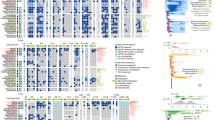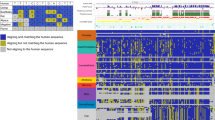Abstract
Histones are best known as the architectural proteins that package the DNA of eukaryotic organisms, forming octameric nucleosome cores that the double helix wraps tightly around. Although histones have traditionally been viewed as slowly evolving scaffold proteins that lack diversification beyond their abundant tail modifications, recent studies have revealed that variant histones have evolved for diverse functions. H2A and H3 variants have diversified to assume roles in epigenetic silencing, gene expression and centromere function. Such diversification of histone variants and 'deviants' contradicts the perception of histones as monotonous members of multigene families that indiscriminately package and compact the genome. How these diverse functions have evolved from ancestral forms can be addressed by applying phylogenetic tools to increasingly abundant sequence data.
This is a preview of subscription content, access via your institution
Access options
Subscribe to this journal
Receive 12 print issues and online access
$189.00 per year
only $15.75 per issue
Buy this article
- Purchase on Springer Link
- Instant access to full article PDF
Prices may be subject to local taxes which are calculated during checkout







Similar content being viewed by others
References
Sandman, K. et al. HMf, a DNA-binding protein isolated from the hyperthermophilic archaeon Methanothermus fervidus, is most closely related to histones. Proc. Natl. Acad. Sci. USA 87, 5788–5791 (1990).
Sandman, K., Pereira, S.L. & Reeve, J.N. Diversity of prokaryotic chromosomal proteins and the origin of the nucleosome. Cell. Mol. Life Sci. 54, 1350–1364 (1998).
Pereira, S.L. et al. Archaeal nucleosomes. Proc. Natl. Acad. Sci. USA 94, 12633–12637 (1997).
Musgrave, D.R., Sandman, K.M. & Reeve, J.N. DNA binding by the archaeal histone HMf results in positive supercoiling. Proc. Natl. Acad. Sci. USA 88, 10397–10401 (1991).
Sandman, K. et al. Growth-phase-dependent synthesis of histones in the archaeon Methanothermus fervidus. Proc. Natl. Acad. Sci. USA 91, 12624–12628 (1994).
Slesarev, A.I. et al. Evidence for an early prokaryotic origin of histones H2A and H4 prior to the emergence of eukaryotes. Nucleic Acids Res. 26, 427–430 (1998).
Ng, W.V. et al. Genome sequence of Halobacterium species NRC-1. Proc. Natl. Acad. Sci. USA 97, 12176–12181 (2000).
Fahrner, R.L. et al. An ancestral nuclear protein assembly: crystal structure of the Methanopyrus kandleri histone. Protein Sci. 10, 2002–2007 (2001).
Decanniere, K. et al. Crystal structures of recombinant histones HMfA and HMfB from the hyperthermophilic archaeon Methanothermus fervidus. J. Mol. Biol. 303, 35–47 (2000).
Luger, K. et al. Crystal structure of the nucleosome core particle at 2.8 Å resolution. Nature 389, 251–260 (1997).
Arents, G. et al. The nucleosomal core histone octamer at 3.1 Å resolution: a tripartite protein assembly and a left-handed superhelix. Proc. Natl. Acad. Sci. USA 88, 10148–10152 (1991).
Ouzounis, C.A. & Kyrpides, N.C. Parallel origins of the nucleosome core and eukaryotic transcription from Archaea. J. Mol. Evol. 42, 234–239 (1996).
Eickbush, T.H. & Moudrianakis, E.N. The histone core complex: an octamer assembled by two sets of protein-protein interactions. Biochemistry 17, 4955–4964 (1978).
Fischle, W., Wang, Y. & Allis, C.D. Histone and chromatin cross-talk. Curr. Opin. Cell Biol. 15, 172–183 (2003).
Wu, R.S., Tsai, S. & Bonner, W.M. Patterns of histone variant synthesis can distinguish G0 from G1 cells. Cell 31, 367–374 (1982).
Bosch, A. & Suau, P. Changes in core histone variant composition in differentiating neurons: the roles of differential turnover and synthesis rates. Eur. J. Cell Biol. 68, 220–225 (1995).
Thatcher, T.H. et al. Independent evolutionary origin of histone H3.3-like variants of animals and Tetrahymena. Nucleic Acids Res. 22, 180–186 (1994).
Waterborg, J.H. & Robertson, A.J. Common features of analogous replacement histone H3 genes in animals and plants. J. Mol. Evol. 43, 194–206 (1996).
Ahmad, K. & Henikoff, S. The histone variant H3.3 marks active chromatin by replication-independent nucleosome assembly. Mol. Cell 9, 1191–1200 (2002).
Yu, L. & Gorovsky, M.A. Constitutive expression, not a particular primary sequence, is the important feature of the H3 replacement variant hv2 in Tetrahymena thermophila. Mol. Cell. Biol. 17, 6303–6310 (1997).
Ausio, J. Histone H1 and evolution of sperm nuclear basic proteins. J. Biol. Chem. 274, 31115–31118 (1999).
Hennig, W. Chromosomal proteins in the spermatogenesis of Drosophila. Chromosoma 111, 489–494 (2003).
Palmer, D.K. et al. A 17-kD centromere protein (CENP-A) copurifies with nucleosome core particles and with histones. J. Cell Biol. 104, 805–815 (1987).
Palmer, D.K. et al. Purification of the centromere-specific protein CENP-A and demonstration that it is a distinctive histone. Proc. Natl. Acad. Sci. USA 88, 3734–3738 (1991).
Henikoff, S., Ahmad, K. & Malik, H.S. The centromere paradox: stable inheritance with rapidly evolving DNA. Science 293, 1098–1102 (2001).
Malik, H.S., Vermaak, D. & Henikoff, S. Recurrent evolution of DNA-binding motifs in the Drosophila centromeric histone. Proc. Natl. Acad. Sci. USA 99, 1449–1454 (2002).
Marzluff, W.F. et al. The human and mouse replication-dependent histone genes. Genomics 80, 487–498 (2002).
Stoler, S. et al. A mutation in CSE4, an essential gene encoding a novel chromatin-associated protein in yeast, causes chromosome nondisjunction and cell cycle arrest at mitosis. Genes Dev. 9, 573–586 (1995).
Buchwitz, B.J. et al. A histone-H3-like protein in C. elegans. Nature 401, 547–548 (1999).
Henikoff, S. et al. Heterochromatic deposition of centromeric histone H3-like proteins. Proc. Natl. Acad. Sci. USA 97, 716–721 (2000).
Takahashi, K., Chen, E.S. & Yanagida, M. Requirement of Mis6 centromere connector for localizing a CENP-A-like protein in fission yeast. Science 288, 2215–2219 (2000).
Talbert, P.B. et al. Centromeric localization and adaptive evolution of an Arabidopsis histone H3 variant. Plant Cell 14, 1053–1066 (2002).
Shelby, R.D., Vafa, O. & Sullivan, K.F. Assembly of CENP-A into centromeric chromatin requires a cooperative array of nucleosomal DNA contact sites. J. Cell Biol. 136, 501–513 (1997).
Vermaak, D., Hayden, H.S. & Henikoff, S. Centromere targeting element within the histone fold domain of Cid. Mol. Cell. Biol. 22, 7553–7561 (2002).
Malik, H.S. & Henikoff, S. Adaptive evolution of Cid, a centromere-specific histone in Drosophila. Genetics 157, 1293–1298 (2001).
Chen, Y. et al. The N terminus of the centromere H3-like protein Cse4p performs an essential function distinct from that of the histone fold domain. Mol. Cell. Biol. 20, 7037–7048 (2000).
Keeling, P.J., Luker, M.A. & Palmer, J.D. Evidence from β-tubulin phylogeny that microsporidia evolved from within the fungi. Mol. Biol. Evol. 17, 23–31 (2000).
Ueda, K. et al. Unusual core histones specifically expressed in male gametic cells of Lilium longiflorum. Chromosoma 108, 491–500 (2000).
Jahn, C.L. et al. An unusual histone H3 specific for early macronuclear development in Euplotes crassus. Proc. Natl. Acad. Sci. USA 94, 1332–1337 (1997).
Douglas, S. et al. The highly reduced genome of an enslaved algal nucleus. Nature 410, 1091–1096 (2001).
Suto, R.K. et al. Crystal structure of a nucleosome core particle containing the variant histone H2A.Z. Nat. Struct. Biol. 7, 1121–1124 (2000).
West, M.H. & Bonner, W.M. Histone 2A, a heteromorphous family of eight protein species. Biochemistry 19, 3238–3245 (1980).
Pehrson, J.R. & Fried, V.A. MacroH2A, a core histone containing a large nonhistone region. Science 257, 1398–1400 (1992).
Chadwick, B.P. & Willard, H.F. A novel chromatin protein, distantly related to histone H2A, is largely excluded from the inactive X chromosome. J. Cell Biol. 152, 375–384 (2001).
Rogakou, E.P. et al. DNA double-stranded breaks induce histone H2AX phosphorylation on serine 139. J. Biol. Chem. 273, 5858–5868 (1998).
Chen, H.T. et al. Response to RAG-mediated VDJ cleavage by NBS1 and γ-H2AX. Science 290, 1962–1965 (2000).
Mahadevaiah, S.K. et al. Recombinational DNA double-strand breaks in mice precede synapsis. Nat. Genet. 27, 271–276 (2001).
Rogakou, E.P. et al. Initiation of DNA fragmentation during apoptosis induces phosphorylation of H2AX histone at serine 139. J. Biol. Chem. 275, 9390–9395 (2000).
Celeste, A. et al. Histone H2AX phosphorylation is dispensable for the initial recognition of DNA breaks. Nat. Cell Biol. 5, 675–679 (2003).
Rogakou, E.P. et al. Megabase chromatin domains involved in DNA double-strand breaks in vivo. J. Cell Biol. 146, 905–916 (1999).
Thatcher, T.H. & Gorovsky, M.A. Phylogenetic analysis of the core histones H2A, H2B, H3, and H4. Nucleic Acids Res. 22, 174–179 (1994).
Yu, G.L., Hasson, M. & Blackburn, E.H. Circular ribosomal DNA plasmids transform Tetrahymena thermophila by homologous recombination with endogenous macronuclear ribosomal DNA. Proc. Natl. Acad. Sci. USA 85, 5151–5155 (1988).
Fernandez-Capetillo, O. et al. H2AX is required for chromatin remodeling and inactivation of sex chromosomes in male mouse meiosis. Dev. Cell 4, 497–508 (2003).
Allis, C.D. et al. hv1 is an evolutionarily conserved H2A variant that is preferentially associated with active genes. J. Biol. Chem. 261, 1941–1948 (1986).
Jackson, J.D. & Gorovsky, M.A. Histone H2A.Z has a conserved function that is distinct from that of the major H2A sequence variants. Nucleic Acids Res. 28, 3811–3816 (2000).
Stargell, L.A. et al. Temporal and spatial association of histone H2A variant hv1 with transcriptionally competent chromatin during nuclear development in Tetrahymena thermophila. Genes Dev. 7, 2641–2651 (1993).
Meneghini, M.D., Wu, M. & Madhani, H.D. Conserved histone variant H2A.Z protects euchromatin from the ectopic spread of silent heterochromatin. Cell 112, 725–736 (2003).
Madigan, J.P., Chotkowski, H.L. & Glaser, R.L. DNA double-strand break-induced phosphorylation of Drosophila histone variant H2Av helps prevent radiation-induced apoptosis. Nucleic Acids Res. 30, 3698–3705 (2002).
Clarkson, M.J. et al. Regions of variant histone His2AvD required for Drosophila development. Nature 399, 694–697 (1999).
Fan, J.Y. et al. The essential histone variant H2A.Z regulates the equilibrium between different chromatin conformational states. Nat. Struct. Biol. 9, 172–176 (2002).
Santisteban, M.S., Kalashnikova, T. & Smith, M.M. Histone H2A.Z regulates transcription and is partially redundant with nucleosome remodeling complexes. Cell 103, 411–422 (2000).
Costanzi, C. & Pehrson, J.R. Histone macroH2A1 is concentrated in the inactive X chromosome of female mammals. Nature 393, 599–601 (1998).
Richler, C., Dhara, S.K. & Wahrman, J. Histone macroH2A1.2 is concentrated in the XY compartment of mammalian male meiotic nuclei. Cyt. Cell. Genet. 89, 118–120 (2000).
Costanzi, C. & Pehrson, J.R. MACROH2A2, a new member of the MARCOH2A core histone family. J. Biol. Chem. 276, 21776–21784 (2001).
Ellegren, H. Dosage compensation: do birds do it as well? Trends Genet. 18, 25–28 (2002).
Pehrson, J.R. & Fuji, R.N. Evolutionary conservation of histone macroH2A subtypes and domains. Nucleic Acids Res. 26, 2837–2842 (1998).
Martzen, M.R. et al. A biochemical genomics approach for identifying genes by the activity of their products. Science 286, 1153–1155 (1999).
Angelov, D. et al. The histone variant macroH2A interferes with transcription factor binding and SWI/SNF nucleosome remodeling. Mol. Cell 11, 1033–1041 (2003).
Aul, R.B. & Oko, R.J. The major subacrosomal occupant of bull spermatozoa is a novel histone H2B variant associated with the forming acrosome during spermiogenesis. Dev. Biol. 242, 376–387 (2002).
Wolffe, A.P. Centromeric chromatin. Histone deviants. Curr. Biol. 5, 452–454 (1995).
Author information
Authors and Affiliations
Corresponding author
Ethics declarations
Competing interests
The authors declare no competing financial interests.
Rights and permissions
About this article
Cite this article
Malik, H., Henikoff, S. Phylogenomics of the nucleosome. Nat Struct Mol Biol 10, 882–891 (2003). https://doi.org/10.1038/nsb996
Published:
Issue Date:
DOI: https://doi.org/10.1038/nsb996
This article is cited by
-
Establishment of an Agrobacterium-mediated genetic transformation and CRISPR/Cas9-mediated mutagenesis of haploid inducer genes in Pak-choi plants (Brassica rapa ssp. chinensis)
Plant Biotechnology Reports (2024)
-
Knockout tales: the versatile roles of histone H3.3 in development and disease
Epigenetics & Chromatin (2023)
-
Acoel single-cell atlas reveals expression dynamics and heterogeneity of adult pluripotent stem cells
Nature Communications (2023)
-
Decoding allelic diversity, transcript variants and transcriptional complexity of CENH3 gene in Brassica oleracea var. botrytis
Protoplasma (2023)
-
Management of dog sperm parameters and gut microbiota composition with Lactobacillus rhamnosus supplementation
Veterinary Research Communications (2023)



